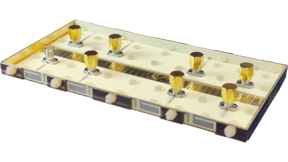Public defence in Radio Science and Engineering, M.Sc.(Tech.) Harri Varheenmaa
- Public defence from the Aalto University School of Electrical Engineering, Department of Electronics and Nanoengineering

The title of the thesis: Space-Saving Antenna Solutions for Mobile Devices
Doctoral student: Harri Varheenmaa
Opponent: Prof. Ping Jack Soh, University of Oulu, Finland
Custos: Prof. Ville Viikari, Aalto University School of Electrical Engineering, Department of Electronics and Nanoengineering
Mobile phones are an inseparable part of modern society. Streaming music and videos, paying by phone in a store, and operating artificial intelligence services over the internet are already commonplace. Without antennas, this would not be possible. Fast connections and increased data capacity improve user experience, and to achieve this, phones use higher frequencies and several antennas, referred to as a multiple-input multiple-output system. In any case, lower-frequency antennas are still required for their better coverage due to less atmospheric attenuation. To achieve these, even more antennas are crammed into mobile phones.
Fitting all the antennas into the phone is not an easy task. Antennas are currently located on the rim of the phone, but the space there is running out. The antennas not only compete for the existing space with each other, but other components of the phone also take their share. The rim houses the volume button, the charging port, and the SIM card slot. The space for antennas is further reduced by today's popular edge-to-edge screens, whereas in the past screen bezels could be used as part of the antenna structure. To top it all, the design of antennas is complicated by the fact that metallic rims are desired for the device due to better aesthetics and durability. To put it simply, the presence of metal makes antennas worse. The problem with previously used solutions for this problem is that they are complex and take up precious space.
This thesis presents solutions for squeezing more mobile phone antennas into the available space. The challenges caused by the metal rim and the edge-to-edge screens are solved with a compact antenna design. By placing two antennas that operate in different frequency bands in the same volume, instead of next to each other, even more space is saved. Currently, the back cover is the only unutilized location for an additional antenna and there are two reasons for that. First, the antenna in the back cover radiates always toward the user, which should generally be avoided. Second, the metallic battery near the antenna reduces again antenna performance.
Space-saving antennas will remain topical since the space inside phones will likely not increase.
Keywords: millimeter-wave, mobile antenna, multiple-output multiple-input, shared aperture antenna, specific absorption rate, sub-6 GHz
Thesis available for public display 10 days prior to the defence at: https://aaltodoc.aalto.fi/doc_public/eonly/riiputus/
Contact:
| [email protected] |
Doctoral theses in the School of Electrical Engineering: https://aaltodoc.aalto.fi/handle/123456789/53
- Published:
- Updated: